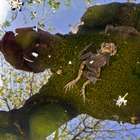Anthropocene: tended wildernesses
Posted June 19, 2013 by Theun KarelseAlong with the plants, trees and animals, the first Europeans who moved North after the receding ice of the last glacial period, entered into an unknown landscape that had only recently seen tremendous geological violence and was still dotted with dead ice lakes. At present the landscape of the Anthropocene is starting to reveal itself to us in all of its devastation. It looks like it needs our tending.
Marc van Roosmalen's writing gives a detailed insight into the lives of non-human species; what is important to a Spider monkey, what daily challenges does it face? It's like spending time with a foreign family, a different culture and seeing how they manage. Marc describes how the Brazilian rainforest predominantly renews and evolves through interactions the between fruit-bearing flora and fruit-eating fauna. He is adamant that conservation efforts for these forests should be based on the living requirements and ethology of native frugivores like the Spider monkey. Without them it is impossible for the forest to renew or restore itself. /3 This is a close parallel to a relationship between indigenous peoples and their landscapes beautifully described by M. Kat Anderson as tending the wild. /4 This is a symbiosis, the foragers and the forest are a single unit.
The jargon used by ecologists to describe (elements of) natural systems can be extraordinarily poetic. Just imagine something like: vegetation forecasting, climate excursions, cryptic refugia or species plasticity. Can ecological restoration or rewilding be seen as an artistic endeavor? Where the limits between land-art and horticulture, or installation-art and forestry become blurred?
Being in a functional ecosystem can be at times completely overwhelming. You find yourself engulfed by a vortex of movement, color, sound, smell and sheer growing power. When you focus on a specific area, an individual creature there is a stillness, a private life that takes place in the gentle rhythm of the endless cycle of seasons. That individual presence may have little legs or flowers and meeting it temporarily pushes the green maelstrom of the entire ecosystem to the background. Being in wilderness combines these two states of mind in endless alternation.
A section of the forest, where a neat lawn and roses stood before; naturalistic forest garden project led by Wim Verzandvoort.
While working to create something like a naturalistic forest you become aware of the subtleties of bio-organic distribution; not just of trees or plants, but also the movement of light, changes in moisture levels, animal activity and the distribution of leaves, mosses, roots, seeds, shoots, branches and the scattering dead wood in nature. The Umwelt of a restoration ecologist must be crammed full of details and patterns like these?! /5 Reading van Roosmalen you start to wonder how a species' perception is impacted by being a frugivore, folivore, etc. and how remnants of our culinary past may still affect our world view. I often wonder about this at the supermarket when confronted with packaging designs.
Van Roosmalen makes a far stretching observation; the Amazon forests with their fruit bearing trees and fruit or seed eating species, can only survive if their success as a species is limited. If a tree adopts a strategy by which all off its offspring germinate successfully, it will become its own competitor for the very limited resources available and go extinct. Obviously the same goes for seed or fruit eaters that don't allow for any seeds to germinate. So both parties avoid becoming too successful. Van Roosmalen argues that indigenous peoples have adopted similar population limiting strategies; ritualized behavior which eliminates prime hunters in communities and thereby drasticly reducing the potential growth of the community. Sacrifice is portrayed here as part of a highly evolved culture, not a rudimentary one. That may be of interest to Europe moving into the Anthropocene.
Notes:
- Felix Riede: Journeying in unfamiliar landscapes, pg08 in Prehistoric Journeys ed. Vicky Cummings,Robert Johnston.
- Suprabha Seshan is an ecologist working at the Gurukula Botanical Sanctuary, India: from Rainforest Etiquette #2 a conversation on habitat restoration March 2013.
- Marc van Roosmalen: Barefoot through the Amazon.
- M Kat anderson: Tending the Wild.
- Jacob von Uexküll: Umwelt see wikipedia article
Created: 15 Jul 2021 / Updated: 23 Oct 2021



